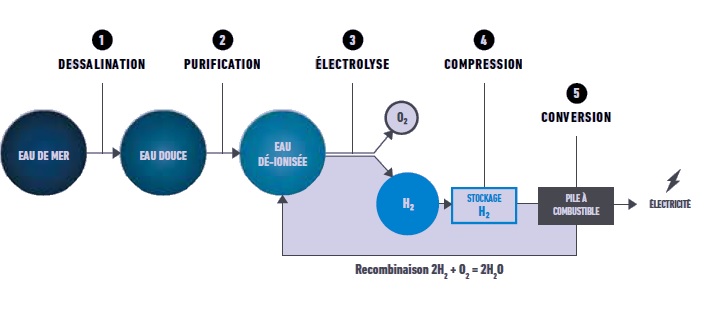Energy Observer showcases a 100% renewable energy mix, combining solar, wind and hydro energy, coupled with a hydrogen storage system using lithium-ion batteries, as well as a complete hydrogen system. This outstanding technological feat is the result of twenty years’ R&D at CEA-LITEN (Laboratory for Innovation in New Energy Technologies and Nanomaterials ). CEA-LITEN intends to prove the maturity of the embedded technologies and the potential of energy mixes and renewables for a clean, efficient and innovative future.
The Energy Observer team of crew members, naval architects and thirty or so engineers from CEA-LITEN had many challenges to face. As well as meeting the objective of complete self-sufficiency and zero emissions, technologies had to be adapted to the rather hostile environment at sea, with salinity, humidity and swell, for example. An added constraint was the actual architecture of the catamaran, as the various parts of the energy system had to be installed in areas that are narrow and hard to get to. Equipment weight is another problem: the lighter the vessel, the less energy it consumes. In the end, the entire energy system weighs in at 1.3 tonnes, compared with the 30 tonnes that could normally be expected for this type of installation.
Details of the energy systems developed by CEA
Solar energy – Two different technologies were used to make the 120 square metres of solar panels. The made-to-measure panels covering the deck are curved so that they hug the rounded hull. The bifacial panels with heterojunctions are designed to capture direct sunlight as well as the light reflected by the water and the boat. They are installed aft and along the entire length of the hull.
Storage - The lithium-ion batteries will be used for short-term storage and will supply two separate power systems - one 400 V and one 24 V. The first is used to manage power demands, propulsion, electrolysis and hydrogen compression; the second for life on board and for instrumentation and control and safety equipment.
A complete hydrogen system will be used for long-term storage. For this purpose, Energy Observer is equipped with a desalination system, an electrolyser, tanks and a fuel cell. This system will produce hydrogen from sea water, store it on board and use it to power the fuel cell. Electrical energy from the fuel cell will be fed back into the circuit, while reaction heat will be used to heat domestic water on board.
Complete system management - In addition to the equipment for capturing and storing energy on board the catamaran, CEA-LITEN’s teams developed the system for managing and monitoring the entire energy system. The goal is to ensure optimum operation according to resources, which vary depending on time of day and weather, and to the vessel’s itinerary. All the navigation data will be analysed in real time by the engineers in order to propose suitable scenarios.

Three operating modes
When the boat is berthed, it does not consume any energy apart from what is needed on board. The solar and wind energy is used to recharge the Li-ion batteries. All the surplus energy goes to the electrolyser production and hydrogen storage system.
In favourable sailing conditions, generation and consumption are evenly balanced. The batteries are used to cover power demands and intermittency management for the various energy sources. While the smart kite is in use for long crossings, the propeller will go on turning and act as a dynamo and, in fact, become a hydrogenerator with its reversible motors.
When solar and wind energy is not enough to meet demand, the fuel cell, running on the stored hydrogen, provides the boat with yet more energy.
Find out more about CEA technologies for Energy Observer on cea.frAbout Energy ObserverEnergy Observer is the first energy self-sufficient vessel, propelled by hydrogen and renewable energies, with zero emissions: 120 m2 of solar panels, two vertical-axis wind turbines, one smart traction kite, and two electric motors that can be converted into hydrogenerators. This energy mix makes Energy Observer the first boat in the world capable of producing its hydrogen from sea water. Victorien Erussard, Energy Observer’s captain, started the project in 2015, with the backing of AccorHotels and Thélem assurances, since joined by Delanchy and a number of other companies including Air Liquide, Prysmian group, Toyota and Delta Dore. On 26 June 2017, Energy Observer left Saint-Malo, its port of registry, on a six-year round-the-world voyage. The first ports of call are in France, starting in Paris this summer and ending in Monaco next December.
About CEA
The French Alternative Energies and Atomic Energy Commission (CEA) is a public research organisation working in four main areas: defence and security, nuclear and renewable energies, technological research for industry and fundamental research.
Research carried out at CEA supports the growth and development of renewable energy. Working with industry leaders, CEA leads R&D programmes focusing on solar power (thermal, thermodynamic and photovoltaic), hydrogen and energy recovery from bioresources, etc. It also works on integrating their use in the energy mix: low energy-consumption buildings, positive energy regions and smart grids with electricity storage systems.
The research engineers at CEA-LITEN are proud to have contributed their expertise in developing cutting-edge technologies in the fields of renewable energy, energy efficiency, storage and innovative materials for the design of the entire energy production system of Energy Observer.